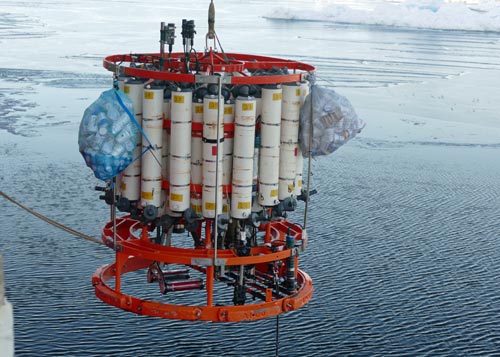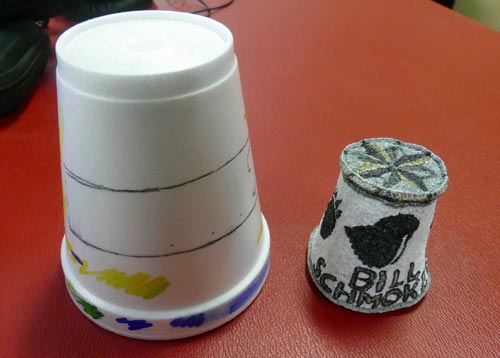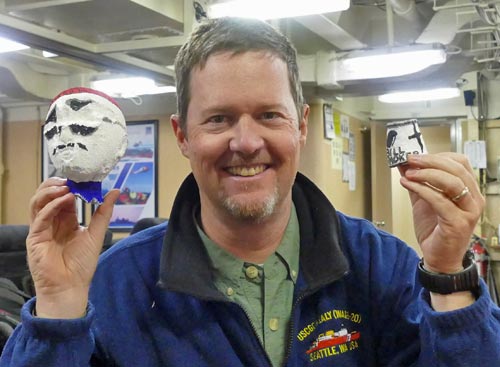Cruise Day 36
Speed 4 knots (kts) Course 223° (SW) Location Alpha Ridge, ~250 nautical miles south of N. Pole Depth 2785 m
GO DEEPER DISCUSSION: (see previous journal for the questions.)
As mammals, seals have to breath air. So even though ringed seals are unmatched by polar bears when swimming underwater, they are vulnerable when they come up to breathe at an ice hole, when they rest on the ice, and when they are too young to swim yet, living in a den within the ice along a pressure ridge. Polar bears have many tricks up their sleeve such as waiting at a breathing hole for hours for a seal to return or slipping into the sea and swimming up to an ice edge underwater to ambush a resting seal.
TODAY’S JOURNAL:
We’ve made gradual progress since our last stop, working hard through thicker and very tight ice. Tight ice means that there aren’t leads within view on either side of the ship, which would give the ice somewhere to go as the Healy breaks through. So we’ve been moving slowly or backing and ramming when we lose our momentum or get stopped by a pressure ridge. This is the ice that made us decide to reverse our planned loop early in the cruise. Seeing the slow progress we made all morning, we are grateful that the ice has had another three or so weeks to soften and thin compared to when we were “supposed” to be crossing this area. We’re just about to park in a lead for a short water sampling station followed by an ice station. Then we’ll transit again to about 85° N for another “super” station + ice station, so that will be a long stop. After several days of windy, cloudy, snowy weather the sun broke out today. It felt like sunrise to see reds and oranges under the cloud cover as it thinned, although the sun hasn’t dipped below the horizon for many weeks now up here. As we have seen before, the clearing was accompanied by higher atmospheric pressure and a plunging thermometer, which is now reading just below 10° F after several days near 30°. Although the wind is light, it bites any exposed skin, with a wind chill just a whisker above 0° F.
 As the clouds broke up this morning it looked like a beautiful sunrise, but the sun hasn’t actually risen or set for several weeks on our cruise.
As the clouds broke up this morning it looked like a beautiful sunrise, but the sun hasn’t actually risen or set for several weeks on our cruise.
There’s a long tradition on oceanographic research cruises to decorate Styrofoam coffee cups and send them into deep water with a CTD cast. The immense pressure of the deep ocean crushes the gas bubbles in the Styrofoam, shrinking the cups down to a fraction of their original size. It is kind of like doing a 3-D Shrinky Dink project, and many very creatively-decorated cups were on hand to send into 4000+ meter deep water at the North Pole.
 The ODF 36-bottle rosette had extra gear on board in the form of mesh bags filled with Styrofoam cups and heads when it went deep down to ~4200 meters deep at the North Pole.
The ODF 36-bottle rosette had extra gear on board in the form of mesh bags filled with Styrofoam cups and heads when it went deep down to ~4200 meters deep at the North Pole.
I also brought along a Styrofoam wig head (the kind they use to model wigs, hats, sunglasses, etc.) for the big squeeze. Mesh bags of cups and a few Styrofoam heads traveled to about 4200 meters deep in the Amundsen Basin atop the pole. Since pressure increases by about 1 atmosphere (the average pressure at sea level) for every 10 meters of depth, our Styrofoam was feeling about 420 times the pressure at its deepest point than it was under when it was made. The results are pretty dramatic!
 Before the North Pole deep CTD cast, I decorated a Styrofoam cup and a wig head for a couple of unique souvenirs.
Before the North Pole deep CTD cast, I decorated a Styrofoam cup and a wig head for a couple of unique souvenirs.
My cup began with an outer diameter of 8.0 cm at the top and 5.0 cm at the bottom, with a side height of 9.2 cm. After the dive the dimensions were 4.5 cm outer diameter at the top, 3.3 cm at the bottom, and a side height of 4.9 cm.
 On the left is the same type of cup I used for the big squeeze, and on the right is my decorated cup after a trip to about 4200 meters deep at the North Pole.
On the left is the same type of cup I used for the big squeeze, and on the right is my decorated cup after a trip to about 4200 meters deep at the North Pole.
The head was essentially life-sized before the squeeze, with a circumference of 53.5 cm right above the brow and a neck circumference of 35.5 cm at its thinnest. After experiencing abyssal plain conditions the head came back with a circumference of 30.4 cm at the brow and 13.9 cm at the neck. It also ended up with a big crack through the eyes – talk about a splitting headache!!
 After a trip to water ~4200 meters deep, the Styrofoam cup and head show signs of a high-pressure situation!
After a trip to water ~4200 meters deep, the Styrofoam cup and head show signs of a high-pressure situation!
GO DEEPER!
Let’s estimate how the volume of the shrunken head compares to its original volume. For simplicity, assume the head’s shape to be spherical, with a starting circumference of 53.5 cm and an ending circumference of 30.4 cm. Look up the formula for calculating the volume of a sphere if you need to, and see how the starting and ending volumes compare.
Aloft Con web cam updated every hour
Healy Track
That's all for now. Best- Bill

